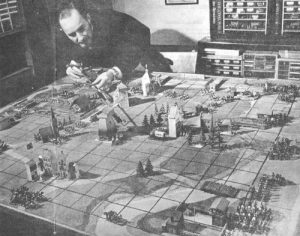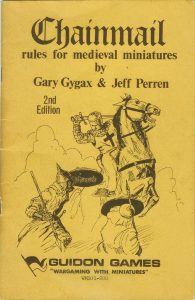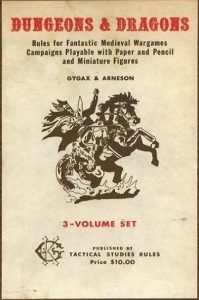Let’s trace Dungeons and Dragons back to wargaming ancient Mesopotamia. You know, for fun.
In 1913, a war-game was created with the title Little Wars: A Game for Boys of Twelve Years of Age to One Hundred and Fifty and for That More Intelligent Sort of Girl Who Likes Boys’ Games and Books.

So…that’s quite a title, huh? More interesting is the game’s creator: none other than science fiction legend H.G. Wells. Even more interesting is the story that led Wells to create Little Wars. But we’re jumping ahead.
Almost immediately after history’s first wars, nerds went to work. Indeed, archaeologists discovered a simple war game that was designed to represent the battles between Egypt and Mesopotamia. (Yet here we are in 2018, kidding ourselves into thinking that Super Contra is old school.)
There’s more. Chinese generals and statesmen liked to play a board game called Go around 200 BCE. Not long after–in good ‘ole 500 CE–the game Chess was created in Northern India, another early war game with its knights and pawns. Yet Chess is a really simple simulation, if the term ‘simulation’ even holds for it.
But in Europe after the Enlightenment, nerdy thinkers began to posit that war could be understood and simulated using mathematical models. So war games were iterated to become increasingly accurate. One of those games was an expanded version of Chess called Koenigspiel (1664). The idea was that players would learn useful military principles simply by playing.

These iterations brought some of the gaming conventions that we are still familiar with today. For example, Kriegspiel, the followup to Koenigspiel, had a 60 page rulebook and was played on a board with 1,666 squares that was eventually expanded to 3,600, each painted different colors to represent different terrain. Nowadays, we simply buy a pre-printed map pack with our standard one-inch grid, which as it turns out is basically the same way they were kicking it in 1798.
Napoleon–hand in his coat–brought further innovation to war gaming. Specifically, it was the Napoleonic Wars that served as the muse that inspired game creators, ever eager to fully simulate military tactics in order to train officers. In 1811, Baron George Leopold van Reiswitz created Instructions for the Representation of Tactical Maneuvers under the Guise of a Wargame. Judging by the title, this was a game that took itself seriously.
The game also introduced more mechanics that have stuck with games today. It was played on a special table that held sand or special terrain. And ceramic models were placed on the table to represent obstacles, while little red and blue miniature soldiers represented units.
Units had “speeds” and movement rules, and dice determined the success or failure of actions. The game was promoted to Prussian officers but many felt the rules to too complex, which made one wonder how they were deemed capable to lead men to their deaths if they weren’t able to understand a board game. But ¯\_(ツ)_/¯.
Yet the most interesting thing about Instructions for the Representation of Tactical Maneuvers under the Guise of a Wargame was that it required a judge to adjudicate the outcome, a role that was clearly an early forebear for the dungeon master.
Speaking of dungeon masters, let’s now speak of Gary Gygax–the World’s Greatest Dungeon Master™–and tie a little ribbon back to H.G. Wells. But buckle up, because a lot of things happened in the decades after Little Wars: A Game for Boys of Twelve Years of Age to One Hundred and Fifty and for That More Intelligent Sort of Girl Who Likes Boys’ Games and Books.

First, H.G. Wells was a pacifist. He wasn’t interested in creating a military simulation. He wanted to dial up the fun and, as a side benefit, he hoped that playing out aggressive impulses on a board might diminish aggressive impulses in the real world. In other words, cooperation was introduced to war gaming.
This slowly bled into the 1960s American wargaming subculture. A University of Minnesota student named Dave Wesley thoroughly enjoyed war-games but like H.G. Wells, he wasn’t particularly fond of the hyper-competitive nature of them, nor the mindless, rote battle-after-battle simulation they were known for.
Anti-Vietnam sentiment was also pronounced on college campuses at this time, so they tried a friendly little experiment at the University of Minnesota. They played as an army of knights who were defending a small medieval village against invading Huns. As players would join, they’d allow them to assume roles of various villagers. Enter roleplaying.
The game’s rules were a flop but it had a player by the name of Dave Arneson, another UofM student. And the same year that UofM students were experimenting with roleplaying during war-games, Gary Gygax organized the 1st annual GenCon in Lake Geneva, WI, just a few hours away.
Gygax immediately went to work modifying the admittedly rough ruleset. The result was Chainmail, a relatively popular product that sold 100 copies a month at $3 apiece. What Chainmail did was introduce basic rules for battle between individual combatants rather than full units meant to simulate real-life war campaigns. In came the imagination.

As Gygax and Arneson further collaborated, games made a hard pivot from from tradition battlefield simulations toward indoor settings such as castles and dungeons. Gygax also displayed a Mad Hatter’s ability to draw from various fantasy-fiction sources, notably the work of JRR Tolkien.
No disrespect to the Empire, but not everyone is British. Benedict Cumberbatch is. Doctor Who. And Meghan Markle, certainly. Also, definitely hobbits halflings. Tooks and Brandybocks are but only some Bagginses. Indeed, nearly all of Gygax’s creations drew from the rich vein Tolkien, as well as pulp works like Conan and others.
Gygax demonstrated that the models of simulation that traced all the way back to Mesopotamia through the Napoleonic Wars could be applied to pretty much anything the human imagination could achieve.

Other innovations brought simple role-playing, while yet others brought party co-operation, a judge to keep play moving, and a focus on individual characters rather than simulated military units. Then Gary Gygax took all those gaming innovations and assigned them XP, leveling them up.
The end result was a January 1974 print run of 1,000 copies of a tiny little booklet titled Dungeons and Dragons: Rules for Fantastic Medieval Wargame Campaigns Playable with Paper and Pencil and Miniature Figures. The rest, as they say, is history.

